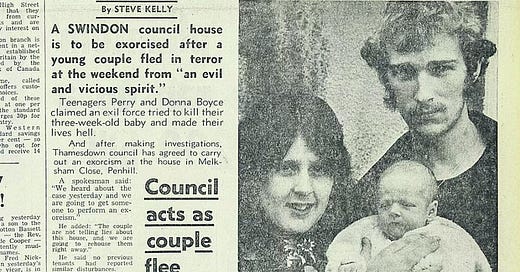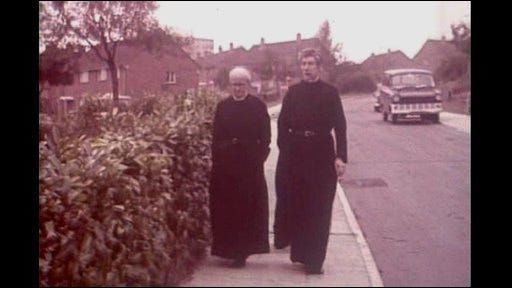Poltergeists, from the German for "noisy spirit," have been a source of fascination and fear for centuries. While claims of harassing spirits date back to the 1st century, documented cases became more prevalent in the 17th century. Some researchers, like Nandor Fodor, have suggested psychokinesis as the cause, noting the common association of poltergeist activity with teenage girls. Others, like Frank Podmore, who conducted early methodical studies in 1896, have concluded that these phenomena are hoaxes, often attributed to mischievous individuals. But in the Swindon suburb of Penhill, a series of poltergeist events has left residents and researchers alike wondering if something more is at play.
Penhill, built in the 1950s to alleviate London's post-war housing shortage, seems to be a particular hotspot for poltergeist activity. Several cases have been reported over the years, each with its own unique and chilling details.
Case 1: The Pellymounter Poltergeist (1973)
Dave and Sheryl Pellymounter, a young couple, moved into a small house on Westbury Road in 1973, unaware of the unsettling experiences that awaited them. Soon after moving in, the couple reported a series of strange occurrences: feelings of being watched, radios turning on and off by themselves, the cooker switching off mysteriously, and belongings being moved around the house. On one occasion, Sheryl heard a loud crash and discovered a chair had been thrown across the kitchen floor. Their three-year-old son refused to enter the hallway, standing at the threshold and crying. They also reported whispering and rustling noises, as if someone was walking by.
The situation escalated to the point where the Pellymounters contacted their local vicar, Father Walker, who in turn brought in Canon Harman from the local Diocese to perform an exorcism. This exorcism, remarkably, was broadcast on the BBC show "Leap in the Dark." During the broadcast, Canon Harman can be heard quoting Psalm 51:7: "Purge me with hyssop, and I shall be clean; wash me, and I shall be whiter than snow.” Hyssop, in biblical tradition, was used for cleansing rituals.
Despite the exorcism, the aftermath remains unclear. No follow-up information could be found to confirm whether the ritual was successful in ridding the house of its unwanted guest. Skeptics might attribute the strange events to the stress and sleep deprivation experienced by a young couple with a small child. However, the documented exorcism and the broadcast suggest something more unsettling may have occurred.
Case 2: The Melksham Close Poltergeist (1980)
Less than a mile away from the Pellymounter's home, another poltergeist case unfolded in 1980. Teens Perry and Donna Boyce, just weeks after the birth of their baby, claimed an invisible force was tormenting them in their Melksham Close home. They reported objects being thrown, a door being broken, and lights switching on and off. What makes this case particularly compelling is the council's reaction. After investigating the claims, they not only offered to rehouse the couple immediately but also arranged for an exorcism to be performed. A council spokesperson stated, “The couple are not telling lies about this house, and we are going to rehouse them straight away.”
The Boyce's ordeal began on their very first night in the house. Perry described being terrified, hearing their dog howling and the door banging as if someone was trying to break in. The following morning, the attic door was open, the pantry door had been ripped open, and the bolts on the back door were broken. Family and friends who stayed with the couple also witnessed strange occurrences. One friend recounted making coffee with Donna when the kitchen door began to rattle violently. They fled the kitchen in fear. Later, in the living room, the lights began to flash on and off, and a cassette recorder levitated and flew across the room, narrowly missing the baby's cot.
A History of Hauntings
The two cases above are not isolated incidents. Local newspaper archives reveal a series of reported poltergeist activity in Penhill over several decades:
1963: "Poltergeist terror for Penhill family," Wiltshire Gazette and Herald.
1975: "Poltergeist terror for Penhill man," Swindon Evening Advertiser.
1982: "Poltergeist returns to Penhill," Wiltshire Gazette and Herald.
1990: "Poltergeist strikes again in Penhill," Swindon Evening Advertiser.
2000: "Haunted by the ghost of a Victorian gent," Swindon Evening Advertiser.
These reports, spanning nearly 40 years, paint a picture of a neighborhood plagued by unexplained phenomena. While some cases mention specific details like objects moving or ghostly figures, the recurring theme is one of disturbance, fear, and the unsettling feeling of an unseen presence.
Is Penhill truly a hotspot for poltergeist activity? Are these events explainable by natural phenomena, psychological factors, or hoaxes? Or is there something more mysterious at work in this corner of Swindon? The recurring nature of the reports and the council's unusual actions in the Boyce case certainly raise intriguing questions. Perhaps further investigation into these Penhill poltergeists could shed light on the nature of these "noisy spirits" and the reasons behind their unsettling presence
Listen to our Poltergeists of Wessex episode here
.




